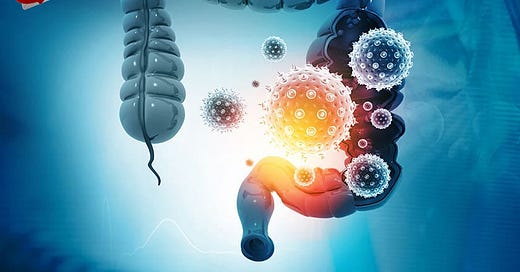★ TOP STORY
Could the Right Bacteria Be the Missing Link in Your Health Journey?
A disrupted gut microbiome can quietly hijack your energy, mood, immune function, and metabolism - leading to weight gain, chronic inflammation, and even brain fog. Discover how restoring microbial balance with the right probiotic and plant-based strategy may be the key to unlocking whole-body healing.
Advertisement
Delight Your Family and Friends with Biodynamic® Ingredients
From seed to table, Solspring® Biodynamic® foods offer fresh, clean, and nutrient-dense ingredients you and your family will love. Delight your taste buds with full-bodied flavors while supporting regenerative agriculture, the livelihood of farmers and a sustainable future.
📈 TRENDING NEWS
Is Clutter Quietly Wrecking Your Nervous System? Why Spring Cleaning Might Be the Cure
Spring cleaning isn't just about tidying up your home. It's a powerful reset for your body and mind that experts say helps reduce stress, boost mood, and even improve your physical health.
Weekly Health Quiz: Plant-Based Milks, Food Additives, and Antidepressants
Take this week's quiz to see how well you remember what you read on Mercola.com last week.
🔥 HOT
Breaking News: What You Need to Know
Up-to-date info on the latest health-related news happening in the world.
Advertisement
Train Hard, Recover Smarter
Push limits in the gym - support your body afterward. Our performance supplements help you bounce back faster and go further. Because what you do outside the gym matters just as much as what you do in it. Shop now and upgrade your routine!
Disclaimer: The entire contents of this website are based upon the opinions of Dr. Mercola, unless otherwise noted. Individual articles are based upon the opinions of the respective author, who retains copyright as marked. The information on this website is not intended to replace a one-on-one relationship with a qualified health care professional and is not intended as medical advice. It is intended as a sharing of knowledge and information from the research and experience of Dr. Mercola and his community. Dr. Mercola encourages you to make your own health care decisions based upon your research and in partnership with a qualified health care professional.
Mercola.com, 125 SW 3rd Place, Suite 205, Cape Coral, FL 33991
US Number: (877) 985-2695 | Intl Number: 1 (239) 599-9500
© 1997-2025 Dr. Joseph Mercola. All Rights Reserved.
*These statements have not been evaluated by the Food and Drug Administration. These products are not intended to diagnose, treat, cure, or prevent any disease.









While this article centers around rebooting our microbe balance; How much of what so many of us have formally been doing can not take full affect until we pave the way for the newly realized need for a foundation the lead microbes lay down for those microbes to follow impacting not only our moods, mental acuity, our immune system and probably much more.
Gui shares how exercise, physical activity has an important impact also.
On a personal note, I find myself having memory problems. Some it seems may be just there is so much collapse of learned Foundation Beliefs across our social landscapes, but also, in this alternative health sphere, once bringing welcomed, but now seen as partial relief. As this has once been a personal experience coming from not just similar extreme summer heat, but also the change in better foods releasing what I believe are toxins absorbed years ago. Perhaps as we move along this better path, because I have experienced good results so far with some of the new recommendations, I sense a possible need for ways to gather up the heavy metals or the chem toxins we just can't seem to keep out of our bodies, lives. Milk thistle, Broken Cell Chlorella have worked well in the past, but perhaps they too need a protocol so as not to interfere with a Gut Reboot. It just seems there is so much to absorb, relearn in so many subjects and the experienced before release of toxins are causing myself some memory problems.
These reviews analyze the influence of exercise on the gut microbiome and overall health. Moderate exercise promotes a healthy immune system, whereas prolonged high-intensity exercise can cause leaky gut and subsequent systemic inflammation, which can disrupt microbial balance. The combination of aerobic and resistance training significantly affects bacterial diversity, which is associated with a lower prevalence of chronic metabolic disorders. Furthermore, exercise improves gut microbiome diversity, increases SCFA production, improves nutrient utilization, and modulates neuronal and hormonal pathways, thereby improving gut barrier integrity. Probiotic supplementation is associated with decreased inflammation, improved athletic performance, and fewer gastrointestinal disorders, suggesting a mutually influential relationship between the gut microbiome and physical activity. The bidirectional relationship between physical activity and the gut microbiome is exemplified by how exercise can promote beneficial bacteria, while a healthy gut microbiome can potentially improve exercise capacity through various mechanisms.
Firmicutes and Bacteroidetes are the two most abundant phyla, representing up to 90% of the gut flora in adults. An increase in Firmicutes and a decrease in Bacteroidetes in terms of their relative abundance under exercise intervention. The Firmicutes phyla contain several genera of highly diverse bacteria that are beneficial for improving gut health in adults, while the increased abundance of Bacteroidetes is often associated with poorer microbial composition and certain unhealthy habits such as a sedentary lifestyle and a high-fat diet. The F/B ratio is often proposed as a potential biomarker in research on human gut flora due to its high sensitivity to exercise intervention or other environmental factors. Consider a high F/B ratio as a marker of dysbiosis in adults, especially in obesity. While our results showed a slight increase in the F/B ratio after the exercise intervention, physical exercise played a positive role in modulating microbial ecology and improving gut health. This is likely explained by the high protein intake of elite athletes and the high variability in relative abundance between different individuals and metabolic characteristics. Currently, the change in the F/B ratio is not sufficient to consider exercise interventions as the gold standard for regulating the gut flora beneficial to health.
At the genus level, Ruminococcus gauvreauii, Anaerostipes, and an uncultured genus of Lachnospiraceae, all belonging to the SCFA-producing phylum Firmicutes, were found to have significantly increased relative abundance in the adult gut after the exercise intervention, which was positively correlated with insulin sensitivity and cardiorespiratory fitness. A sharp increase in Bifidobacterium abundance was reported in many studies in this review, suggesting a positive association with acetate production. The acetate metabolic pathway in intestinal epithelial cells could increase the release of IL-18 and then activate the epithelial IL-18 receptor and promote intestinal barrier integrity . The genera Roseburia hominis and Akkermansia muciniphila were found to have significantly higher relative abundance in adults performing active exercise compared to sedentary individuals , and both genera were shown to have a beneficial impact on gastrointestinal tract health, lipid metabolism, and the host immune system by producing butyrate. Furthermore, acetate and butyrate producers, represented by Bifidobacterium and Akkermansia muciniphila, were found to be significantly increased following an 8-week exercise training intervention.
Fu rthermore, the gut microbiota plays a key role in gut-brain communication by generating neuroactive molecules. The predominant inhibitory neurotransmitter in the CNS, γ-aminobutyric acid (GABA), is crucial for both brain activity and gastrointestinal physiological processes. Moderate exercise increased hypothalamic GABA levels, leading to decreased resting blood pressure and sympathetic tone. Propionate and GABA levels increased significantly in responders after 12 weeks of exercise intervention. The gut microbiota can synthesize and regulate neurotransmitter activity and interact with the CNS to regulate brain functions. Several microbial species such as Bacteroides can convert glutamate to GABA, and strains of the Lactobacillus genus have been shown to be GABA-containing products. Furthermore, dopamine and norepinephrine can be synthesized in the gastrointestinal tract during stress. Physical exercise stimulates intestinal sensory nerves, which leads to a suppression of monoamine oxidase expression.
In short, it is known that the gut microbiota improves mood symptoms, including stress and anxiety, and may mediate positive benefits in the brain. This experiment showed a dramatic increase in BDNF and neurotransmitter concentrations, improvements in cognitive ability, and mood stabilization.
There is an association between changes in the microbiota and CNS diseases, such as Alzheimer's disease (AD), Parkinson's disease (PD), multiple sclerosis (MS), and autism spectrum disorder (ASD). We also summarize studies on various types of microecological agents (such as probiotics, prebiotics, synbiotics, and postbiotics) and exercise in improving symptoms of CNS diseases. Among neurotrophic factors, BDNF is a widely studied neurotrophic factor. BDNF plays a crucial role in neuronal plasticity, synaptic transmission, neuronal resilience to stress, neuronal differentiation and maturation, and the activation of other supporting molecules such as NF-κB.
Studies have shown that in the early stages of AD, BDNF levels in the blood and brain of patients are relatively low, and BDNF levels positively correlate with cognitive function. Research by Mattson et al. has shown that exercise significantly increases BDNF expression in the brain. In fact, one study found that in APP/PS1 mice, 12 weeks of treadmill running increased BDNF levels in the hippocampus threefold while reducing Aβ deposition by 50% and significantly improving spatial memory.
https://www.mdpi.com/2072-6643/16/21/3663 (2024).--
https://www.mdpi.com/2072-6643/16/7/1070 (2024).--
https://www.mdpi.com/1422-0067/25/19/10742 (2024).---
https://www.mdpi.com/2072-6643/17/10/1686 (2025).--
https://www.mdpi.com/2072-6643/17/11/1769 (2025).--
https://www.mdpi.com/2072-6643/17/11/1769# (2025).--